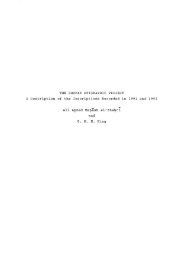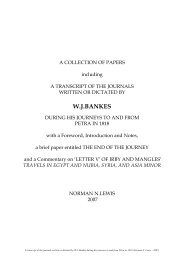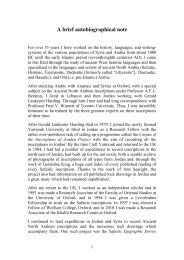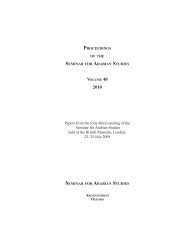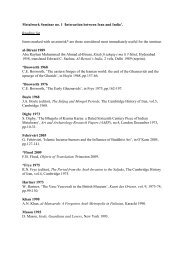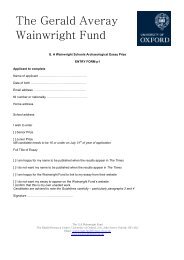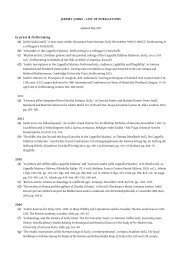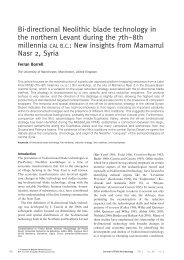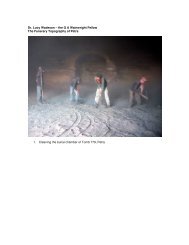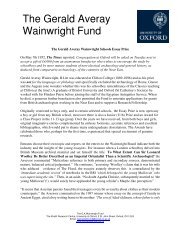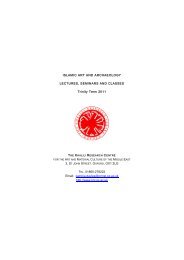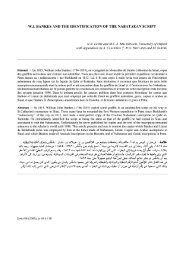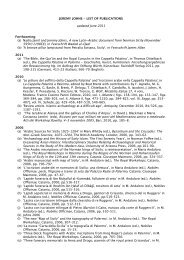Reflections on the linguistic map of pre-Islamic Arabia - Khalili ...
Reflections on the linguistic map of pre-Islamic Arabia - Khalili ...
Reflections on the linguistic map of pre-Islamic Arabia - Khalili ...
Create successful ePaper yourself
Turn your PDF publications into a flip-book with our unique Google optimized e-Paper software.
THE LINGUISTIC MAP OF PRE-ISLAMIC ARABIA<br />
i) Ancient South <strong>Arabia</strong>n [ASA] (sudarabique ancien, Altsüdarabisch)<br />
Sayhadic<br />
Sabaic<br />
Madhabic [formerly called ‘Minaean’/‘Minaic’. The written language used by <strong>the</strong> Minaeans and apparently<br />
inherited from <strong>the</strong>ir <strong>pre</strong>decessors in <strong>the</strong> regi<strong>on</strong> <strong>of</strong> Wādī Madāb, in <strong>the</strong> Yemeni Jawf].<br />
Qatabanic<br />
Hadramitic<br />
N<strong>on</strong>-Sayhadic<br />
Himyaritic [<strong>the</strong> native language <strong>of</strong> <strong>the</strong> Himyarites, <strong>of</strong> which a handful <strong>of</strong> possible examples remain]<br />
O<strong>the</strong>r n<strong>on</strong>-Sayhadic texts (ZI 11?, Ja 2353?)<br />
? ‘Native Minaic’ [this should be restricted to any evidence that may appear for <strong>the</strong> language <strong>the</strong> Minaeans<br />
spoke]<br />
?? The language <strong>of</strong> <strong>the</strong> Dh<strong>of</strong>ar dipinti [at <strong>pre</strong>sent undeciphered]<br />
ii) Modern South <strong>Arabia</strong>n [MSA] (sudarabique moderne, Neusüdarabisch)<br />
Batw hw arī<br />
Hw arsūsī<br />
Hobyōt<br />
Jibbālī<br />
Mehrī<br />
Socotrī<br />
Fig. 2.<br />
Suggested terminology for languages and scripts: II. South <strong>Arabia</strong>n (sudarabique, Südarabisch).<br />
in Oman, sou<strong>the</strong>astern Yemen and Socotra.<br />
Although <strong>the</strong> terms ‘North <strong>Arabia</strong>n’ and<br />
‘South <strong>Arabia</strong>n’ are both drawn from geography,<br />
<strong>the</strong> groups <strong>the</strong>y describe are defined<br />
by very different criteria. ‘North <strong>Arabia</strong>n’<br />
describes a group <strong>of</strong> dialects (possibly<br />
languages?) which appear remarkably<br />
homogeneous <strong>linguistic</strong>ally. For each <strong>of</strong><br />
<strong>the</strong>se, its ph<strong>on</strong>emic repertoire, morphology<br />
and (as far as we can tell) syntax, find<br />
closer parallels within <strong>the</strong> group than with<br />
any language outside it.<br />
By c<strong>on</strong>trast, <strong>the</strong> term ‘South <strong>Arabia</strong>n’ is<br />
based more <strong>on</strong> geographical than <strong>linguistic</strong><br />
criteria. While <strong>the</strong>re appear to be fairly<br />
close internal relati<strong>on</strong>ships within <strong>the</strong><br />
Modern South <strong>Arabia</strong>n group, it is questi<strong>on</strong>able<br />
to what extent all <strong>the</strong> languages<br />
within <strong>the</strong> Ancient South <strong>Arabia</strong>n Sayhadic<br />
group really bel<strong>on</strong>g toge<strong>the</strong>r <strong>on</strong> <strong>linguistic</strong><br />
grounds. Indeed, future discoveries may<br />
prompt a drastic regrouping and relabelling<br />
<strong>of</strong> all <strong>the</strong> Ancient South <strong>Arabia</strong>n languages.<br />
Equally, <strong>the</strong>re seems to be no ques-<br />
ti<strong>on</strong> <strong>of</strong> any lineal ‘descent’, at least from <strong>the</strong><br />
Sayhadic languages to <strong>the</strong> Modern South<br />
<strong>Arabia</strong>n t<strong>on</strong>gues (20). Thus, ‘South <strong>Arabia</strong>n’<br />
is a geographical term which at<br />
<strong>pre</strong>sent covers three quite distinct types <strong>of</strong><br />
language group, each defined by different<br />
criteria. ‘Sayhadic’ re<strong>pre</strong>sents <strong>the</strong> <strong>of</strong>ficial,<br />
written, languages <strong>of</strong> <strong>the</strong> ancient South <strong>Arabia</strong>n<br />
kingdoms, a grouping based as much<br />
<strong>on</strong> <strong>the</strong> fact that <strong>the</strong>y are all relatively well<br />
documented, as <strong>on</strong> <strong>linguistic</strong> features.<br />
‘N<strong>on</strong>-Sayhadic’ is simply a Restklassenbildung<br />
for any language indigenous to ancient<br />
South <strong>Arabia</strong>, which cannot be defined<br />
as Sayhadic; while MSA is <strong>the</strong> <strong>on</strong>ly<br />
<strong>on</strong>e <strong>of</strong> <strong>the</strong> three to be defined by <strong>linguistic</strong><br />
criteria.<br />
To some extent, <strong>the</strong> c<strong>on</strong>trast between<br />
North <strong>Arabia</strong>n and South <strong>Arabia</strong>n reflects<br />
<strong>the</strong> extent <strong>of</strong> our knowledge <strong>of</strong> <strong>the</strong> two. The<br />
<strong>linguistic</strong> data available for Ancient North<br />
<strong>Arabia</strong>n is relatively sparse and it is possible<br />
that if we had as much material for it as we<br />
do for Ancient South <strong>Arabia</strong>n we might dis-<br />
31



